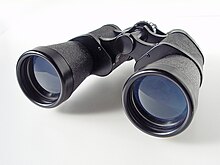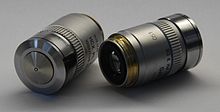Objective (optics)


In optical engineering, the objective is the optical element that gathers light from the object being observed and focuses the light rays to produce a real image. Objectives can be a single lens or mirror, or combinations of several optical elements. They are used in microscopes, binoculars, telescopes, cameras, slide projectors, CD players and many other optical instruments. Objectives are also called object lenses, object glasses, or objective glasses.
Types[]
Microscope[]

The objective lens of a microscope is the one at the bottom near the sample. At its simplest, it is a very high-powered magnifying glass, with very short focal length. This is brought very close to the specimen being examined so that the light from the specimen comes to a focus inside the microscope tube. The objective itself is usually a cylinder containing one or more lenses that are typically made of glass; its function is to collect light from the sample.
Microscope objectives are characterized by two parameters: magnification and numerical aperture. The magnification typically ranges from 4× to 100×. It is combined with the magnification of the eyepiece to determine the overall magnification of the microscope; a 4× objective with a 10× eyepiece produces an image that is 40 times the size of the object. Numerical aperture for microscope lenses typically ranges from 0.10 to 1.25, corresponding to focal lengths of about 40 mm to 2 mm, respectively.
A typical microscope has three or four objective lenses with different magnifications, screwed into a circular "nosepiece" which may be rotated to select the required lens. These lenses are often color coded for easier use. The least powerful lens is called the scanning objective lens, and is typically a 4× objective. The second lens is referred to as the small objective lens and is typically a 10× lens. The most powerful lens out of the three is referred to as the large objective lens and is typically 40–100×. Some microscopes use an oil-immersion or water-immersion lens, which can have magnification greater than 100, and numerical aperture greater than 1. These objectives are specially designed for use with refractive index matching oil or water, which must fill the gap between the front element and the object. These lenses give greater resolution at high magnification. Numerical apertures as high as 1.6 can be achieved with oil immersion.[1]
Photography and imaging[]

Camera lenses (usually referred to as "photographic objectives" instead of simply "objectives"[2]) need to cover a large focal plane so are made up of a number of optical lens elements to correct optical aberrations. Image projectors (such as video, movie, and slide projectors) use objective lenses that simply reverse the function of a camera lens, with lenses designed to cover a large image plane and project it at a distance onto another surface.[3]
Telescopes[]

In a telescope the objective is the lens at the front end of a refracting telescope (such as binoculars or telescopic sights) or the image-forming primary mirror of a reflecting or catadioptric telescope. A telescope's light-gathering power and angular resolution are both directly related to the diameter (or "aperture") of its objective lens or mirror. The larger the objective, the brighter the objects will appear and the more detail it can resolve.
See also[]
References[]
- ^ Kenneth, Spring; Keller, H. Ernst; Davidson, Michael W. "Microscope objectives". Olympus Microscopy Resource Center. Retrieved 29 Oct 2008.
- ^ Stroebel, Leslie; Zakia, Richard D. (1993). The Focal Encyclopedia of photography. p. 515.
- ^ Keller, Max (1999). Weiss, Johannes (ed.). Light Fantastic: The Art and Design of Stage Lighting. Prestel. p. 71. ISBN 9783791321622.
- Lenses
- Microscope components